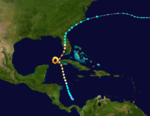1910 Atlantic hurricane season
| 1910 Atlantic hurricane season | |
|---|---|

Season summary map
|
|
| Seasonal boundaries | |
| First system formed | July 7, 1910 |
| Last system dissipated | October 21, 1910 |
| Strongest storm | |
| Name | Cuba |
| • Maximum winds | 150 mph (240 km/h) |
| • Lowest pressure | 924 mbar (hPa; 27.29 inHg) |
| Seasonal statistics | |
| Total storms | 5 |
| Major hurricanes (Cat. 3+) |
1 |
| Total fatalities | >100 |
| Total damage | $1.250 million (1910 USD) () |
| Tropical storm (SSHWS) | |
| Duration | August 23 – August 26 |
|---|---|
| Peak intensity | 40 mph (65 km/h) (1-min) |
| Tropical storm (SSHWS) | |
| Duration | August 26 – August 31 |
|---|---|
| Peak intensity | 45 mph (75 km/h) (1-min) |
| Category 2 hurricane (SSHWS) | |
| Duration | September 5 – September 15 |
|---|---|
| Peak intensity | 110 mph (175 km/h) (1-min) 965 mbar (hPa) |
| Category 2 hurricane (SSHWS) | |
| Duration | September 24 – September 27 |
|---|---|
| Peak intensity | 100 mph (155 km/h) (1-min) |
| Category 4 hurricane (SSHWS) | |
| Duration | October 9 – October 21 |
|---|---|
| Peak intensity | 150 mph (240 km/h) (1-min) 924 mbar (hPa) |
The 1910 Atlantic hurricane season was the period during the summer and fall of 1910 in which tropical cyclones formed in the North Atlantic Ocean. The season was fairly inactive, with only five storms; however, three grew into hurricanes and one became a major hurricane. The season got off to a late start with the formation of a tropical storm in the Caribbean Sea on August 23. September saw two storms, and the final tropical cyclone—Hurricane Five—existed during October. All but one of the storms made landfall, and the only cyclone which remained at sea had some effects on the island of Bermuda.
The season's first storm had limited reported impacts on land, and the subsequent system caused more severe damage in southern Texas and northern Mexico. Hurricane Three dropped torrential rainfall on Puerto Rico before striking the same region as the previous cyclone. Hurricane Four bypassed Bermuda to the east, where some property damage was reported. Hurricane Five was the most catastrophic storm of the season, buffeting western Cuba for an extended period of time as it slowly executed a counterclockwise loop. Death tolls from the hurricane are estimated in the hundreds.
In addition to the five official tropical cyclones, a disturbance in the middle of September that tracked from east of the Lesser Antilles to off the coast of Canada was studied for potential classification. Despite producing gale-force winds, the system was likely extratropical in nature, and any time it may have spent as a tropical storm was brief.
The first tropical cyclone of the season developed on August 23, in the eastern Caribbean Sea. Not believed to have strengthened further, the storm tracked west-northwestward and struck southwestern Hispaniola. It quickly weakened to a tropical depression as it turned more toward the northwest and crossed northern Cuba. On August 26, the depression passed through the Bahamas, east of the Florida Peninsula. Heading due north, the storm had transitioned into an extratropical cyclone by the next day. An area of high pressure to the north and east of the storm was said to have prevented it from recurving out to sea, and the cyclone skirted the eastern coast of North Carolina before being listed as dissipated east of the Delmarva Peninsula. The storm reportedly caused heavy precipitation on August 29 and 30 in Georgia and the Carolinas, while ships at sea reported high winds, rough seas and heavy rainfall.
...
Wikipedia









